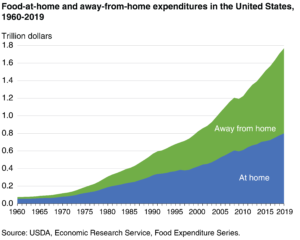
By Mary Miranowski RDN, Home Cook and Nutrition Educator
Think of me as your Home Economics teacher. Wait, they don’t call it Home Ec anymore. It’s Family and Consumer Sciences (FCS) now. Many of you may not recognize either term from school. This class used to be required in middle school, but about 20 years ago it became optional and has been fading away ever since. I was lucky. I’m a boomer that had the class, and I also learned a ton about making great tasting food from my Mom. Growing up, I remember some of my friends’ parents didn’t want them near the kitchen. Home Ec class was the only place they learned the basics about the life skill of cooking (Lavelle et al, 2016).

Life skill? Yes, life skill. I hope you will agree that eating delicious foods is one of the most enjoyable and satisfying things we do. It brings J-O-Y to life. Turns out creating delicious food at home will also bring you joy in capital letters. And what’s more, cooking brings independence and better health to life. All while saving you money.
For real, cooking is the smart thing to do. But why is our country doing less of it? And it’s not just from a lack of FCS classes. In 1970 families spent 26% of their food budget eating outside of home, double that (50%) in 2009, and in 2019, a new all-time high of 55% (USDA 2020).  The end result: young people are learning less about cooking at home and eating more processed convenience and ready-made foods than ever. At the same time, 1 of every 5 kids and teens in the US has obesity (NCHS 2018), and the young person with obesity is at 80% higher risk to be an adult with obesity (AACAP 2016).
The end result: young people are learning less about cooking at home and eating more processed convenience and ready-made foods than ever. At the same time, 1 of every 5 kids and teens in the US has obesity (NCHS 2018), and the young person with obesity is at 80% higher risk to be an adult with obesity (AACAP 2016).
But let’s talk nutrition and not weight loss diets. Simply put, food is the fuel that provides the energy for everything you do; how you feel throughout the day, handle stress, learn and perform at sports. For better or worse, food fuels your growth, your grades and your future. In fact, did you know foods prepared at home give you more nutrients like fiber, calcium and iron along with the energy they provide (Guthrie et al, 2002)? This means knowing how to cook gives you the ability to fill your tank with the highest quality fuel.
What about restaurants, take-out and fast food? The answer is yes, but within limits. Let’s be real. Sometimes you take a short-cut to just put something in your stomach. Or you go out for a special meal on the weekend to celebrate. Try to make eating out a once or twice a week thing on top of the meals provided for you at school. Nuff said.
Let’s get cooking!

The first thing to learn about is the basic equipment you need. This list of 20 items (cookware, utensils, dishes, tools and gadgets) may be considered essential by some (CookSmarts 2020). Don’t be overwhelmed. While you will need the majority of items on the list, I’ve been having fun cooking for an awfully long time without an immersion blender or fish turner. A regular turner/spatula that flips grilled sandwiches is plenty good, and a cheese grater is more useful than a microplane zester. Also, if you are missing a piece of kitchen equipment, chances are there is a work around only a Google search away. For example, no potato peeler? Check out this video for taking the skins off potatoes. Final word on equipment. Don’t let the cost get in your way. Look around at what you already have at home. Then find a thrift or Good Will store near you. They always have a big selection of used kitchen stuff.

Next, test your food safety smarts. Taking this 8 question quiz will take you all of 5 minutes to complete, and I think you’ll be surprised at some of the answers (Henneman 2020). Half the fun is cooking for someone else, and the last thing you’d want is to make anyone sick, yourself included.
Before you decide on what you are going to make, consider if you need a partner. Is there a family member that cooks at your house, or a friend who wants to learn along with you? The buddy system works because you’ve made a plan that somebody else also wants to follow. Depending on your age, do you need someone to show you how to use the stove and oven? Or take you grocery shopping?

The first skill to get down is chopping. Review some general tips on knife skills and chop up some raw vegetables. Put some Ranch dressing and peanut butter on the side for dipping. Two vegetables that require chopping and carry nutrients young people often need more of are bell peppers (any color) and carrots (USDA 2019). Add a couple others you like or are curious about. For example, cucumber or celery. Or go with apples and make it a fruit and vegetable plate! A crisp apple cut in wedges and dipped in peanut butter is also delicious!

Another skill involves using different cooking methods like boiling, pan frying and roasting. Vegetables and eggs make low cost and high nutrient ways to get practice here. You could do sweet potatoes two ways, one boiled and one roasted in the oven. And a great way to practice pan frying is with eggs: try scrambled eggs and eggs over-easy. Why not find out which one you like better?

From here the possibilities of what you can make are really endless, and probably only limited by time and money. That’s the Ec-economics part of Home Ec. I’ve provided 8 easy, tasty and economical recipes to get you started at the Nutrition-IQ website. These are main dish items such as Chicken Tenders, Spaghetti and Meatballs, Hash Brown Breakfast Bake, Mini Pizzas and Wrap Sandwiches. Cost per serving ranges from approximately 90 cents to a little over $2. I’ve even included shopping lists to make it as easy as possible. Remember: always check to see which ingredients you may already have in the cupboard, refrigerator or freezer before you go to the store. Looking in these places is also a great way to get inspired.
What will you make next?
American Academy of Child & Adolescent Psychiatry (AACAP). (2016). Facts for Families No. 79. Obesity in Children and Teens. https://www.aacap.org/AACAP/Families_and_Youth/Facts_for_Families/FFF-Guide/Obesity-In-Children-And-Teens 079.aspx#:~:text=Studies%20have%20shown%20that%20a,biological%2C%20behavioral%20and%20cultural%20factors.
CookSmarts. (2020). The Basics: Essential Kitchen Tools. https://www.cooksmarts.com/cooking-guides/create-a-functional-kitchen/20-must-have-kitchen-tools/
Danovich T. (14 June 2018). National Public Radio (NPR). Despite A Revamped Focus On Real-Life Skills, ‘Home Ec’ Classes Fade Away. https://www.npr.org/sections/thesalt/2018/06/14/618329461/despite-a-revamped-focus-on-real-life-skills-home-ec-classes-fade-away
Guthrie, J.F., Lin, B.H. & Frazao, E. (2002). Role of food prepared away from home in the American diet, 1977-78 versus 1994-96: changes and consequences. J Nutr Educ Behav, 34:140-50.
Henneman, A. (2020). University of Nebraska-Lincoln. Institute of Agriculture and National Resources. https://food.unl.edu/can-you-pass-food-safety-quiz
Lavelle, F., Spence, M., Hollywood, L. et al. (2016). Learning cooking skills at different ages: a cross-sectional study. Int J Behav Nutr Phys Act, 13:119.
National Center for Health Statistics (NCHS). (2018). Selected Health Conditions and Risk Factors, by Age: United States, Selected Years 1988–1994 through 2015–2016 https://www.cdc.gov/nchs/data/hus/2018/021.pdf Accessed August 4, 2020.
Pan, J. (7 Mar 2018). Taste of Home. The Vanishing Home Economics Class and What Will Be Lost. https://www.tasteofhome.com/article/vanishing-home-economics-class/
United States Department of Agriculture (USDA). (15 June 2020). Economic Research Service. Food Expenditure Series. US food-away-from-home spending continued to outpace food-at-home spending in 2019. https://www.ers.usda.gov/data-products/chart-gallery/gallery/chart-detail/?chartId=58364
USDA Food and Nutrition Service. USDA. (20 Sept 2019). SNAP-Ed ToolKit. Together We Inspire Smart Eating (WISE). UNC Center for Health Promotion and Disease Prevention. https://snapedtoolkit.org/interventions/programs/together-we-inspire-smart-eating-wise/